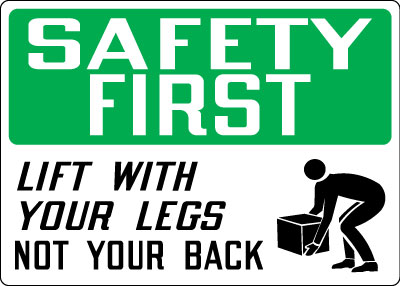Most of you have probably heard that in order to lift safely, you must lift properly. You’re told to “bend your knees not your back”, and “don’t twist as you lift”. This is good advice but sometimes seems to go against human nature. Yet, there are actions you can take to help you lift properly.
1. Get as close to the load as possible: The further the load is from the center line of your body, the greater the strain imposed on your back. If need be, squat down to lift the load and pull it between your legs. This gets it closer to the center of your body and helps prevent the need to bend at the waist. However, since your leg muscles are the largest muscles in your body, they are the biggest energy consumers. Repeated squatting can be very fatiguing, and reduces a person’s ability to lift in this manner for any length of time. In addition to lifting the load, you are also hoisting the majority of your body weight.
2. Avoid picking up heavy objects placed below your knees: Try to see that heavy objects are placed and stored above knee level and below shoulder level. If you suspect the load is too heavy to be lifted comfortably, do not chance it. Use a mechanical aid, break the load down into its component parts, or get help. The most common cause of back injury is overloading.
3. Keep your back straight: This means don’t bend at the waist when reaching to lift an object. Keep the natural arch in your lower back, which distributes the load evenly over the surface of spinal disks, and is less stressful than if the disk is pinched between vertebrae. Bending principally from the hips is acceptable if you maintain the arch in your back, rather than bending at the waist.
4. Glue your hand to your thigh: If you carry a load in one hand, such as when carrying a tool box, place your free hand on the outside of your thigh and mentally “glue” it into position. This will help you maintain correct back alignment rather than lifting and tilting to one side. When carrying a heavy load, side bending can be just as stressful to the spine as bending forward.
5. Tighten your stomach muscles: This technique helps prevent your spine from twisting. If you lift a load and need to place it off to one side, turn by moving your feet. After repeated lifts you might find yourself getting a bit sloppy and forgetting to move your feet. You can overcome this tendency if the place you set the load down is at least one step away from where it is lifted. If you wear a back support belt, wear it low on your trunk and loosen it when you are not lifting.
6. Stay in good physical condition: A protruding stomach is an extra load carried away from the center line of the body, and prevents you from keeping a lifted object close. When you bend at the waist to lift, due to the leverage principal, the load is up to 10 times heavier than its actual weight. A “pot belly” puts extra, stressful weight on the spine.
7. Stretch and loosen up before work: Research has shown that trunk flexibility and mobility is significantly lower in the morning than later in the day, increasing the number and severity of back strains at this time. A few minutes of stretching can warm up cold stiff muscles and tendons and help you avoid an injury.
PDF version is available through the link below.

